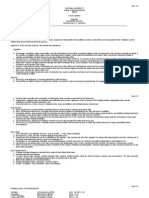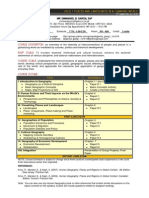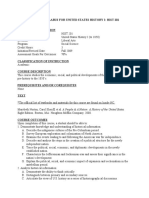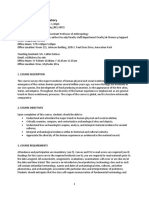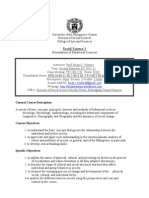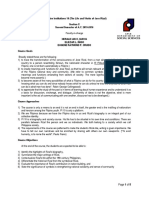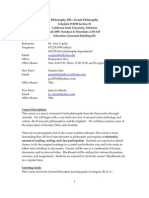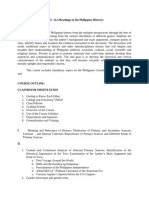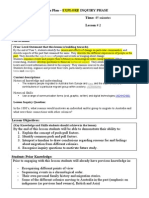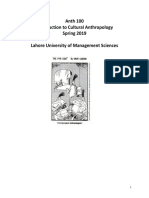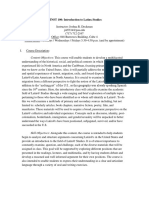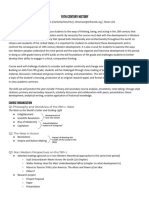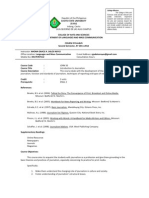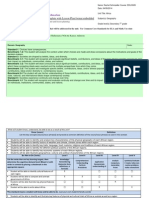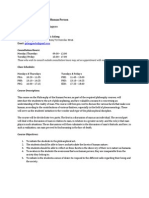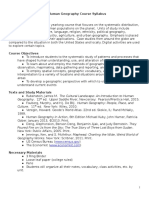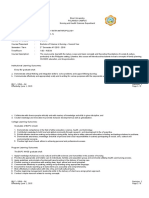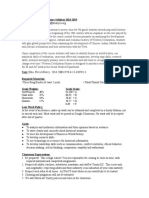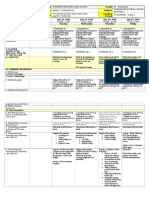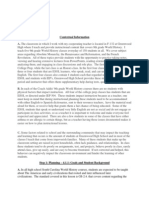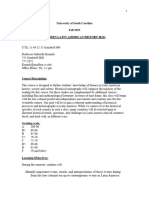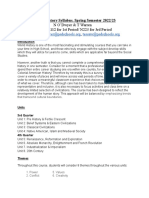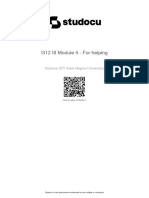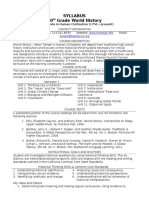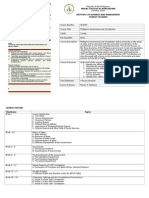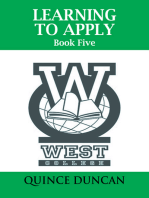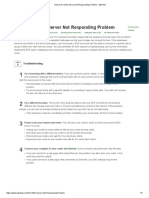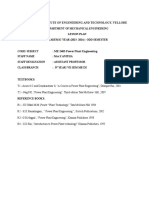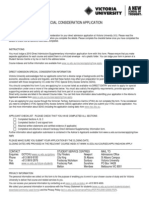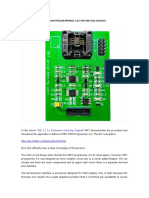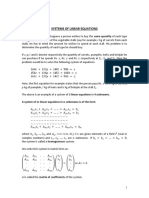History 1 (Philippine History)
History 1 (Philippine History)
Uploaded by
Patrick ParconCopyright:
Available Formats
History 1 (Philippine History)
History 1 (Philippine History)
Uploaded by
Patrick ParconOriginal Title
Copyright
Available Formats
Share this document
Did you find this document useful?
Is this content inappropriate?
Copyright:
Available Formats
History 1 (Philippine History)
History 1 (Philippine History)
Uploaded by
Patrick ParconCopyright:
Available Formats
SYLLABUS History 1 (Philippine History) Credits: 3 units Prerequisites: None Mondays and Thursdays (Sec.
2), 7:00-8:30, Rm 107 Tuesdays and Fridays (Sec 11), 4:00-5:30 Rm 205 Tomas Fonacier Hall. UPV, Miagao, Iloilo Juhn Chris Espia Instructor, 1st Semester, 2012-2013 Email: jcespia@gmail.com Consultation hours: MTh-1:00-4:00 pm, DSS Faculty Room, Miagao Campus TF-1:00-3:00 pm, CAS Faculty Lounge, Iloilo City Campus Course Description: The political, social and cultural development of the Philippines Course Objectives: The course endeavors the student to: 1. Acquire a wider perspective of the history of the Filipinos and to appreciate our rich cultural heritage; 2. Develop historical consciousness and a strong sense of nationhood; and 3. Develop a critical mind and the ability to communicate effectively through the practice of historical method Assessment Scheme: Assessment of students performance in this class will be based on the following: Components 2 Long Examinations (15% each) Final Examination/Assessment Group Report Class Participation Assignments Quizzes Total: Percentage 30% 20% 15% 15% 10% 10% 100%
Long Examinations: Examinations will cover topics outlined in the class syllabus. All examinations will be a combination of essay, objective, problem-solving and questions that require a degree of creativity. Students are therefore expected to be able to express themselves in writing and/or in more creative forms. Final Examination/Assessment: This will be given at the end of the semester. This examination might be written, oral, creative or a combination of all. The instructor reserves the right to substitute the final examination with an activity/and or requirement of equal percentage and merit. Group report: The class will be divided into eight groups. Each group will be in charge of leading the discussion of a particular topic to be determined at the beginning of the semester. It is the 1
job therefore of the reporters to prepare the report outline, visual aids and activities in consultation with the instructor. The report will be graded using the following assessment scheme: Component/Quality Conciseness and validity of the report/presentation Mastery of the report/presentation Soundness and logic in the relationship of activity to relevant local, national and/or global issues presented; and or respective disciplines Creativity of presentation Level of members participation Total Points 5 3 2 Percentage 40 20 10
2 3 15
10 20 100
Class participation: It is expected that students are prepared before coming to class every meeting. This means that you have read, reread, and comprehended, assigned reading/s before entering the class, or at least have tried your best to do so. Coming to class means that you are interested to contribute and learn in classroom activities. Participation in discussion means raising pertinent and well grounded points or questions and not merely reading the book in front of the course instructor and your classmates. Students are also expected to ask pertinent questions during the open forums after the group reports. Quizzes and Assignments: Quizzes are not announced. These are given to check whether you have done your reading assignments or not. It is either in objective or in essay form. Assignments are given either individually or in groups. Class Rules: Attendance and Tardiness: Students with more than six unexcused absences will be automatically given a grade of five (5) unless he or she has formally dropped the course. It is your responsibility to apply for dropping if you have exceeded the limit of unexcused absences, not an Instructors prerogative. Arriving fifteen minutes (15 min.) after the start of the class is considered late. Arriving half an hour after the start of the class is considered absent. Three late marks is equivalent to one absent mark. Rule for Mobile Phones: Mobile phones should be set in silent mode inside the class. If you need to make an important SMS, MMS conversation, or Phone call, you should excuse yourself from the class and conduct your business outside. Due dates: Submission schedules for this class should be promptly observed. Late submissions of assigned works are not accepted. It will be helpful if you finish and print assigned papers at least 24 hours before the due. Be alert with any possible changes in schedules so you wont be confused. Do not hesitate to ask the instructor if you feel uncertain. It is better to be sure than sorry. Class Discussion: Names will be called randomly. Once your name is called you have the right and the duty to contribute. Language is not a barrier for articulating ideas so long as mutual understanding is guaranteed. Being absent on the previous meeting/s means that it is your 2
responsibility to review the discussion on the day/s when you were absent. You are an important participant in learning therefore your contribution in class room learning is highly valued. Students Responsibility: It is expected that you are reading and understanding the literatures assigned to or pertinent with the topic before coming to class. The role of the instructor is only to facilitate in the birthing process of ideas and to assess students performance. Grades are not made but only calculated based on the set of given provided by the students performance. Course Schedule: The discussion will follow the outline. In case of any unforeseeable and unavoidable interruptions a make- up class will be scheduled in a mutually convenient and feasible time and place. Academic Honesty: Plagiarism is a serious academic offense punishable by a grade of 5.0 or expulsion. You are expected to observe proper rules in citing sources and to provide appropriate credits to borrowed ideas. Cheating during examination and quizzes will also be subject to similar rule. TOPIC OUTLINE Day1 Objective/ Learning Outcome After this class activity, students should be able to: a. Know more about the course and the GE Framework b. Set personal and group expectations for the semester c. Know more about themselves and their classmates Content/Activity Reference and/or requirements 1. Metacards and Markers 2. Short Video Clip on the Contemporary Filipino Youth and Philippine History 3. Multimedia Projector Multimedia Projector (See list of references for assigned readings)
1. Introduction and Course Orientation; GE Framework 2. Getting to know each other activity
a. Describe the uses of history; b. Identify the sources of history; c. Differentiate the various approaches to the study of Philippine history; d. discuss the importance of interpreting Philippine history from Filipino point af vietr4 and e. justify the necessity of studying history in understanding one's national
I. Clio's Inspiration: Herstory/History A. Whats in it for us? Its uses and sources B. Making Sense Out of History: Approaches to the study of Philippine History (Lecture-Discussion)
Estimated number of days
identity. a. locate the strategic position of the Philippines in relation to other countries in the region and the world; b. explain the different theories regarding the geological and geographical foundations of the Philippines; and c. point out the importance of geographic features of the Philippines on the development of Philippine history and culture. II. Where on earth are we? The Setting A. Dynamics of the Earth: Geological and Geographical Foundations of the Philippines B. Of gods, giants and grand plots: Tales from the Past (Lecture-Discussion with Visual aids; Interactive Mapping Activity) III. As it Was: The Archipelago Before the White Men Came A. From Adam and Eve to the Tabon Man: Theories Concerning the Peopling of the Philippines B. Boats and Barter: Philippine Trade Patterns, Culture Bearers and Transmitters C. Barangay: The Way We Were D. The Kris and the Crescent: Islam in the Philippines (Lecture-Discussion with Visual Aids and Class Activities Led by Assigned Group Reporters) a. explain the diverse factors that led to Spanish colonization overseas; b. identify and explain the various instruments of IV. In Search of Spices, Souls and Sovereign Rule: Philippine Colonial Society (1570-1763) 4 Multimedia Projector (See list of references for assigned readings) Multimedia Projector Maps of the Philippines, Manila Paper, Markers (See list of references for assigned readings)
3-4
5-9
a. compare and contrast the historical and cultural implications of the various theories of peopling of the Philippines; b. discuss the Philippine trade patterns and their role in the diffusion of culture in to the Philippines prior to the coming of the Spaniards; c. trace the entry and spread of Islam in to the Philippines; and d. synthesize and interpret Asian legacies on Philippine cultures prior to the Spanish Period.
9-12
Pacification" and exploitation used by the Spaniards in the Philippines; c. identify, describe and evaluate the social structures of colonial Philippines, d. explain the patterns of Filipino response to Spanish colonial rule; and e. evaluate the impact of Spanish colonialism on Philippine society and culture,
A. Go East: Rationale of Spanish Colonization Overseas B. The Sword and the Cross: Instruments of Pacification and Exploitation C. The Spanish Bond: Institutions of Colonial Rule D. Agraviados y Padrinos: Patterns of Filipino Response (Lecture-Discussion with Visual Aids and Class Activities Led by Assigned Group Reporters; Panel Discussion; Film Show)
Multimedia Projector (See list of references for assigned readings)
13-16
a. Appraise the impact of European political, economic, and intellectual developments on Philippine society; b. Reconstruct the patterns of economic development in the Philippines as they were influenced by new forms of global trade and communications; c. Identify and explain the cause$ and significance of the reform movements in the Philippines; and d. Explain the factors leading to the Philippine Revolution.
V. Progress and Protests: Formation of a Filipino National Society (17631896) A. Loosening Up: Impact of European Developments on Philippine Society B. Of Steamboats and Sugar Mills: Global Trade and Modernization C. Reform, Radicalism, and Revolution: The Propaganda Movement D. Signs of a Brewing Revolution (Lecture-Discussion with Visual Aids and 5
Multimedia Projector (See list of references for assigned readings)
Class Activities Led by Assigned Group Reporters; Panel Discussion; Film Show) a. To trace the developments leading to the establishment of the Malolos Republic after the outbreak of the revolution; b. Recognize the form of American involvement in the Philippine Revolution; c. Compare and contrast the divergent interest of the elite and the masses and their impact on Philippine Society; and; d. Form generalizations on the impact of the Philippine Revolution on Philippine Society. VI. The Revolution and the Republic: The Transitional Society from the Revolution to The Filipino-American War (1896-1907) A. Nipped in the Bud: The Malolos Republic Multimedia Projector B. Bloody, Blundering Business: American Imperialism in the Philippines C. The Burgis and the Masa: Divergent Interests (Lecture-Discussion with Visual Aids and Class Activities Led by Assigned Group Reporters; Panel Discussion; Film Show) (See list of references for assigned readings)
17-20
a. Identify and explain the reasons for American expansionism; b. Explain the nature of the relationship between Fiiipino and American leadership; 21-24 c. Distinguish the different forms of Filipino resistance to American colonialism; and d. Formulate valid interpretation of the nature and results of American colonialism
VII. A Tale of Two Races: White Mans Manifest Destiny and Little Brown Brothers Bondage (1898-1945) A. Dreams and Visions: America Goes Global B. The Eagle Has Landed: Civilizing with Krags and Chocolates C. Shades of Free Trade: Economic Prosperity and Dependency (Lecture-Discussion 6 Multimedia Projector (See list of references for assigned readings)
with Visual Aids and Class Activities Led by Assigned Group Reporters; Panel Discussion; Film Show)
25-27
a. Assess the significance and impact of the Japanese occupation on Philippine society; b. Describe and analyze the nature of Philippine "Liberation," and; c. Explain the nature of the "collaboration" issue.
VIII. Tatlong Taong Walang Dios: The Japanese Invasion and Occupation (1942- 1945) A. The Rising Sun: Japanese Expansionism in Asia B. Staying Alive: Collaboration, resistance and atbp. C. "I Shall Return": The "Liberation" and Reoccupation" (Lecture-Discussion with Visual Aids and Class Activities Led by Assigned Group Reporters; Panel Discussion; Film Show)
Multimedia Projector (See list of references for assigned readings)
a. Discuss the changing features of the Filipino- American neocolonial relations from Roxas to Marcos; b. Describe the structure of national leadership from Roxas to Marcos ; c. Identify the bases for the declaration sf Martial Law, d. reconstruct the events leading to the "bloodless revolution'; e. evaluate the causes, growth and effects of the HUKBALAHAP, NPA and
IX. Dependent Independence: From Post-War Republic to People Power (1948present) A. It Takes Two to Tango": PhilippineAmerican Neo-colonial Relations B. Games of State: Structure of National Leadership from Roxas to Marcos C. Clear and Present Danger: Martial Law and the Years of Living 7 Multimedia Projector (See list of references for assigned readings)
28-31
Muslim secessionist movements.
Dangerously D. The Continuing Storm: Resistance from the HUKBALAHAP to the NPA and Muslim secessionist Movement E. Ousting the Dictator: People Power Revolution (Lecture-Discussion with Visual Aids and Class Activities Led by Assigned Group Reporters; Panel Discussion; Film Show)
a. Re-evaluate the strategic position of the Philippines in relation to other countries in the region and the world; b. Discuss the contemporary trade patterns and its historical and cultural implications on Philippine society; c. Assess the state of Philippine society and its attendant problems; d. Formulate possible long-term solutions to these problems.
X. Do You Know Where You Are Going To: Globalization and Prospects for the Future A. World Trade Organization and Regional Trade Blocs B. Issues on Body Politics: SARS and the Outbreak and Reemergence of Diseases, Womens Reproductive Health C. The Politics of Information and Communication Technologies: Control and Access in the Third World (Lecture-Discussion with Visual Aids and Class Activities Led by Assigned Group Reporters; Panel Discussion; Film Show; Debate)
32-33
Reserved for Fieldtrips, Review Sessions and Holidays 8
List of References Required references: Agoncillo, Teodoro. History of the Filipino People. Quezon City: Garcia Publishing Co., 1990. Constantino, Renato. The Philippineses: A Past Revisited. Quezon City: Tala Publishing Corp, 1975. ______________________. The Philippines: IheConfnuingPest Queeon City. 1978.
Readings I. Clios Inspiration: History/ Herstory De la Costa, Horacio, S.J. "Three Lectures on History in Historical Bulletin September 1960. pp 15-38. Larkin, John A. (ed.). Perspectives on Philippine Historiography: A Symposium, New Haven: Yale University, Southeast Asia Studies. Pp. 1 - 17. McCoy, Alfred W. "Introduction: The Social History of an Archipelago" in Alfred W. McCoy and Ed C. de Jesus, (eds), Philippine Social History: Global Trade and Local Transformation. Quezon City: Ateneo de Manila University Press, 1981 pp 1-8.
II. Where on earth are we? : The Setting ____________Questions and Challenges in Philippine Prehistory . Professorial Chair Lecture Series Monograph No. 7. Quezon City: University of the Philippines Press, 1975. pp 1-35. Scott, William H. Prehistoric Source Materials for the Study of Philippine History. Quezon City: New Day Publisher, 1984. p. 12- 32. __________________. The Barangay: 16th Century Philippine Culture and Society. Quezon City: Ateneo de Manila University Press, 1994.
III. As It Was: The Archipelago Before the White Men Came Jocana, Landa F. The Philippines at the Spanish Contact. Manila: MCB Enterprise, Inc, 1975. pp 1 -43, Hutterer, Karl. "Pre-Historic Trade and Evolution in Philippine Societies: A Reconsideration" in Karl Hutterer's Economic Exchange and Social Interaction in Southeast Asia. Ann Arbor, 1977 .
IV. In Search of Spices, Souls and Sovereign Rule: Philippine Colonial Society (1570-1763) Cushner, Nicholas P. Spain in the Philippines: From Conquest to Revolution. Quezon City: Ateneo de Manila University, 1973. pp 101 - 152. De la Costa, Horacio. Readings in Philippine History: Selected Historical Texts Presented in a Commentary. Quezon City: Bookmark, 1965. pp. 44-64; 65-97. Phelan, John Leddy. The Hispanization of the Philippines: Spanish Aims and Filipino Responses 1565-1700. University of Wisconsin Madison, 1959. pp. 72-89, 93-135, 137151.
V. Progress and Protests: Formation of a Filipino National Society (1763-1896} Cushner, Nicholas P. Spain in the Philippines: From Conquest to Revolution. Quezon City: Ateneo de Manila University, 1973. pp 187-227. De la Costa, Horacio. Readings in Philippine History: Selected Historical Texts Presented in a Commentary. Quezon City: Bookmark, 1965. pp. 128-196. Fast, Jonathan and Richardson, Kim. Roots of Dependency: Political and Economic Revolution in the 19th Century Philippines . Quezon City: Center for Nationalist Studies, 1979. pp 13 -41. McCoy, Alfred W. The Queen Dies Slowly: The Rise and Decline of Iloilo City" in Alfred W McCoy and Ed C" de Jesus, (eds), Philippine Social History: Global Trade and Local Transformation. Quezon City: Ateneo de Manila University Press, 1981, pp 297358. Warren, James. "Slavery and the Impact-of External Trade: The Sultanate in the 19th Century in McCoy and de Jesus, op. cit. pp.415 -444.
VI. The Revolution and the Republic: The Transitional Society from the Revolution to the Filipino-American War (1896- 1907) Agoncillo, Teodoro A. The Revolt of the Masses: The Story of Bonifacio and the Katipunan . Quezon City: University of the Philippines Press, 1956. pp 276 - 298. _________________________. " Malolos: The Crisis of the Republic. Quezon City: University of the Philippines Press, 1960. pp.621 -678. Fast, Jonathan and Richardson, Kim. Roots of Dependency: Political and Economic Revolution in the 19th Century Philippines . Quezon City: Center for Nationalist Studies, 1979. pp. 55 - 84. Guerrero, Milagros C. " The Provincial and Municipal Elites of Luzon During the Revolution: 1898 -1902 in McCoy and de Jesus. pp- 155 -190. Ileto, Reynaldo C. Pasyon and Revolution : Popular Movements in the Philippines, 1898-1910. Quezon City: Ateneo de Manila University, 1979. May, Glenn Anthony. Inventing a Hero: A Posthumous Recreation of Andres Bonifacio" Quezon City: New Day, 1997.
VII. A Tale of Two Races: White Mans Manifest Destiny and Little Brown Brothers Bondage (1898-1945) Abaya, Hernando. Betrayal in the Philippines. Quezon City, 1965. De la Costa, Horacio. Readings in Philippine History: Selected Historical Texts Presented in a Commentary. Quezon City: Bookmark, 1965: pp.250-271. Friend, Theodore. Between Two Empires. Quezon City, 1969. Hicks, George . The Comfort Women: Sex Slaves of the Japanese Imperial Forces. Singapore: Heiremann Asia, 1995. Ileto, Reynaldo C. Pasyon and Revolution : Popular Movements in the Philippines, 1898-1910. Quezon City: Ateneo de Manila University, 1979. pp. 209-212. Jenkins, Shirley. American Foreign Policy Towards the Philippines. Stanford, 1954. pp.30-31. Leroy, James. The Americans in the Philippines. Boston: Houghton Miffins Co., 1914. Reappraising an Empire: New Perspective in Philippine-American History. Edited by Peter Stanley. Cambridge, Massachusetts, 1983. Salamanca, Bonifacio. The Filipino Reaction to American Rule. Quezon City, 1984. pp. 44-64. 10
VIII. Tatlong Taong Walang Dios: The Japanese Invasion and Occupation (1942-1945)
Sturtevant, David. Popular Uprising in the Philippines 1898-1910. Quezon City: Ateneo de Manila University Press, 1979. pp. 256-266 Thomson , James Jr. C. et al. Sentimentalist Imperialist. New York, New York, 1981. Chapters 8 and 19.
Lichauco Alejandro et al. Imperialism in the Philippines. New York, 1973- pp 129-134 Pomeroy, Stephen .The United States in the Philippines : A Study of Neocolonialism.
IX. Dependent Independence: From Post-War Republic to People Power (1948- present) Bello, Walden et al. Colonial Without Occupation Force" in Development Debacle. The World Bank in the Philippines . San Francisco, California, 1982. pp 13-23; 29 - 39. Brilliantes, Alex and Armales-Ilago, Bienvenida. 1898-1992 The Philippine Presidency. Quezon City: University of the Philippines College of Business and Administration 1994. Constantino, Leticia, R. The Snap Revolution: A Post Mortem. Quezon City: 1986 pp. 1 -27 X. Do you Know Where You Are Going To: Globalization and Prospects for the Future Eviota, Elizabeth Uy. The Political Economy of Gender: Women and Sexual Division of Labor in the Philippines. London : Zed, 1992. Nabudere, Dan. The Political Economy of Imperialism. London: Zed Press Ltd. 1977 pp. 212-281. Shalom, Stephen Rosskamn. The United States and the Philippines: A Study of Neocolonialism. Quezon City: New Day Publishers , 1986. Tanada, Lorenzo . Nationalism: A Summon to Greatness. UP School of Economics. An Analysis of the Philippine Economic Crisis: A Workshop Report. Quezon City, 1986, pp. 1-27. Villegas, Edberto M. Studies in Philippine Political Economy. Manila, 1983, pp. 1 7.
Note: Additional texts and references given in class.
11
You might also like
- Method Statement - ASPHALT CONCRETE WORKS PDFDocument10 pagesMethod Statement - ASPHALT CONCRETE WORKS PDFTAHER AMMAR100% (7)
- Philippine History SyllabusDocument7 pagesPhilippine History Syllabusichu73No ratings yet
- UP Diliman Geog 1 SyllabusDocument4 pagesUP Diliman Geog 1 SyllabusHanaKaz92% (12)
- Course Syllabus For United States History I: Hist 201Document4 pagesCourse Syllabus For United States History I: Hist 201glyph65No ratings yet
- ANT3141 World Prehistory Spr2019Document8 pagesANT3141 World Prehistory Spr2019musain1832No ratings yet
- Practical Research 1: Quarter 4 - Module 1: Qualitative Research DesignDocument23 pagesPractical Research 1: Quarter 4 - Module 1: Qualitative Research DesignAster Jade80% (5)
- Cpms College of Nursing: Assignment ON Electrocardiogram (ECG)Document6 pagesCpms College of Nursing: Assignment ON Electrocardiogram (ECG)Amy Lalringhluani Chhakchhuak100% (3)
- Course Outline Soc Sci 1 Ss Ay 11 12Document6 pagesCourse Outline Soc Sci 1 Ss Ay 11 12Aldren RebaLde100% (1)
- Quizzes and Assignments (10%) : To Check If Students Are Prepared and Have Read About The AssignedDocument5 pagesQuizzes and Assignments (10%) : To Check If Students Are Prepared and Have Read About The AssignedjayNo ratings yet
- Syllabus - LASCSpring 2022Document10 pagesSyllabus - LASCSpring 2022Leonor LamasNo ratings yet
- Syllabus Spring 2014Document15 pagesSyllabus Spring 2014api-248144908No ratings yet
- Course Guide For Philippine Institutions 10 For Section C PDFDocument5 pagesCourse Guide For Philippine Institutions 10 For Section C PDFAmabelle Anne BaduaNo ratings yet
- Phil 290 Fall Thurs SyllabusDocument10 pagesPhil 290 Fall Thurs SyllabusacoplanNo ratings yet
- Sdu American History OverviewDocument4 pagesSdu American History Overviewapi-223081096No ratings yet
- Lesson Plan 1 - EuropeDocument5 pagesLesson Plan 1 - Europeapi-221681121No ratings yet
- LogicDocument10 pagesLogicLee SomarNo ratings yet
- Course Outline in Gec 112Document3 pagesCourse Outline in Gec 112barangaycentro356No ratings yet
- Lesson Plan 1 - The OttomanDocument6 pagesLesson Plan 1 - The Ottomanapi-576107650No ratings yet
- Lesson 2 - ExploreDocument5 pagesLesson 2 - Exploreapi-265620665No ratings yet
- Readings in Philippine History: Aldrin A. AlcantaraDocument19 pagesReadings in Philippine History: Aldrin A. AlcantaraCiarra Kate PazNo ratings yet
- Syllabus Anth 3346 - Cult Div and Power in Us Spring 2019 4-12-2019Document10 pagesSyllabus Anth 3346 - Cult Div and Power in Us Spring 2019 4-12-2019api-316606453No ratings yet
- Anth 100 Introduction To Cultural Anthropology Spring 2019 Lahore University of Management SciencesDocument13 pagesAnth 100 Introduction To Cultural Anthropology Spring 2019 Lahore University of Management SciencesUmer Zaib KhanNo ratings yet
- Midterm in Afro Asian ModuleDocument37 pagesMidterm in Afro Asian ModuleJireh Abrenica100% (1)
- Latino Studies Syllabus Fall 2016Document9 pagesLatino Studies Syllabus Fall 2016api-292570659No ratings yet
- Course OutlineDocument9 pagesCourse OutlineKeikoNo ratings yet
- Philosophy of Man SyllabusDocument3 pagesPhilosophy of Man SyllabusArvella Albay0% (1)
- 20th-Century-HonorsDocument3 pages20th-Century-HonorsbrandonsnowmfsNo ratings yet
- JORN50 SyllabusDocument3 pagesJORN50 SyllabusRhona Grace DelosReyes-PerolaNo ratings yet
- Foe f2015 SyllabusDocument3 pagesFoe f2015 Syllabusapi-264612315No ratings yet
- A SURVEY in AFRO Prelim Module EditedDocument58 pagesA SURVEY in AFRO Prelim Module EditedJireh AbrenicaNo ratings yet
- 609 Lesson PlanDocument9 pages609 Lesson Planapi-252714392No ratings yet
- Syllabus Honors World Studies 9 2022 2023Document4 pagesSyllabus Honors World Studies 9 2022 2023Markus HammerNo ratings yet
- ANT 201.syllabus - Spring 2015.garciacolonDocument5 pagesANT 201.syllabus - Spring 2015.garciacolonIsmael García ColónNo ratings yet
- Ph15 1 Man Syllabus StudentsDocument5 pagesPh15 1 Man Syllabus StudentsKyel LopezNo ratings yet
- 330-101-DW-18 RCauxDocument7 pages330-101-DW-18 RCauxgabriele biunnoNo ratings yet
- Comm 3190 Sp13 Course Syllabus and ScheduleDocument10 pagesComm 3190 Sp13 Course Syllabus and ScheduleWei-feng LiuNo ratings yet
- Government Unit PlanDocument31 pagesGovernment Unit Planapi-242800256No ratings yet
- AP Human Geography Course Syllabus Course OverviewDocument14 pagesAP Human Geography Course Syllabus Course Overviewapi-327790399No ratings yet
- Syllabus 22512Document11 pagesSyllabus 22512api-329795302No ratings yet
- SociologyDocument8 pagesSociologyMarimel SevillaNo ratings yet
- Camacho LTM 621 Lessonplanformat Field Observation 1Document4 pagesCamacho LTM 621 Lessonplanformat Field Observation 1api-264686294No ratings yet
- W Peters Application Draft 4 FinalDocument9 pagesW Peters Application Draft 4 Finalapi-362549590No ratings yet
- Updated Lasc234 SyllabusDocument17 pagesUpdated Lasc234 SyllabusLasc UmdNo ratings yet
- Philosophy EthicsDocument9 pagesPhilosophy EthicsLee Somar100% (1)
- Ant2000 201503 LD PDFDocument12 pagesAnt2000 201503 LD PDFAhmed NourNo ratings yet
- Ubd Final Fall 14Document23 pagesUbd Final Fall 14api-281964936No ratings yet
- Western Civ Honors Trinity Syllabus UpdatedDocument2 pagesWestern Civ Honors Trinity Syllabus Updatedapi-421529403No ratings yet
- Spanish Civ and Cult - CSUSDocument11 pagesSpanish Civ and Cult - CSUSFranciscoNo ratings yet
- Understanding Culture, Society and Politics TTH (10:45-11:45) Wed (2:30-3:00) and Fri (7:30-8:30) 1 Quarter - Week 5Document5 pagesUnderstanding Culture, Society and Politics TTH (10:45-11:45) Wed (2:30-3:00) and Fri (7:30-8:30) 1 Quarter - Week 5ClaireNo ratings yet
- Ecourse POS 2041 American National Government FA13Document7 pagesEcourse POS 2041 American National Government FA13MJSwayNo ratings yet
- Task 4 FinalDocument6 pagesTask 4 Finalapi-242739890No ratings yet
- SYLLABUSmod Lat Amfall 2023Document7 pagesSYLLABUSmod Lat Amfall 2023Juan KirznerNo ratings yet
- Course Syllabus World LiteratureDocument5 pagesCourse Syllabus World LiteratureLiwagonDionesioJr100% (3)
- World History Classroom and Testing NormsDocument4 pagesWorld History Classroom and Testing Normsapi-642969019No ratings yet
- g12-iii-module-4-for-helpingDocument30 pagesg12-iii-module-4-for-helpingcharlenejoy.coNo ratings yet
- Syllabus 10 Grade World History: Major Trends in Human Civilization (1750 - Present)Document3 pagesSyllabus 10 Grade World History: Major Trends in Human Civilization (1750 - Present)api-266994644No ratings yet
- Tarlac College of Agriculture: The College Has A Mission of Providing Higher Education Geared Towards TheDocument6 pagesTarlac College of Agriculture: The College Has A Mission of Providing Higher Education Geared Towards TheMarlon TabilismaNo ratings yet
- Lindenwood University: School of HumanitiesDocument11 pagesLindenwood University: School of HumanitiesClarisse JaymeNo ratings yet
- Bridge to the Future: An Essential Curriculum Guide for New World History TeachersFrom EverandBridge to the Future: An Essential Curriculum Guide for New World History TeachersNo ratings yet
- How To Fix DNS Server Not Responding Problem - WikihowDocument7 pagesHow To Fix DNS Server Not Responding Problem - WikihowNayem Hossain HemuNo ratings yet
- Bonn & Gaston 2005 Richness Ecosystem Conserv SAfDocument18 pagesBonn & Gaston 2005 Richness Ecosystem Conserv SAfKellyta RodriguezNo ratings yet
- LG W4320S Service ManualDocument24 pagesLG W4320S Service ManualeleandrorobertoNo ratings yet
- I. What Is The Theory of Translation?Document10 pagesI. What Is The Theory of Translation?hoadhm71No ratings yet
- AM Series English Software Manual - 20190403-A00-19010980 PDFDocument425 pagesAM Series English Software Manual - 20190403-A00-19010980 PDFMukul GoyalNo ratings yet
- Isolation of Cellulolytic Fungi (Kader & Omar 1998)Document6 pagesIsolation of Cellulolytic Fungi (Kader & Omar 1998)Fery Pamawisa0% (1)
- Rot WaldDocument11 pagesRot WaldGriffin TungNo ratings yet
- ETHICS - Cyber EthicsDocument18 pagesETHICS - Cyber EthicsMoeenuddin Hashim100% (1)
- Eat Pray LoveDocument2 pagesEat Pray LovePrecious Gem Ganir LumabaoNo ratings yet
- Lesson Plan Power PlantDocument5 pagesLesson Plan Power PlantMohanraj SubramaniNo ratings yet
- Cupid and PsycheDocument5 pagesCupid and PsycheIrene Gaviola CatubigNo ratings yet
- Cyclones DPPDocument14 pagesCyclones DPPPatibandla VamsikrishnaNo ratings yet
- Properties - ChemistryDocument3 pagesProperties - ChemistryShannenNo ratings yet
- Om Bio Science & Pharma College Haridwar, U.KDocument8 pagesOm Bio Science & Pharma College Haridwar, U.KVasu ThakurNo ratings yet
- Millet Seminal and Technical - ShefaliDocument1 pageMillet Seminal and Technical - ShefaliShristi ShefaliNo ratings yet
- Construction SafetyDocument2 pagesConstruction SafetyAristotle Rivera100% (1)
- نسخة من 550.4-18 Qualification of Precast Concrete Diaphragm Connections and Reinforcement at Joints for Earthquake Loading and CommentaryDocument24 pagesنسخة من 550.4-18 Qualification of Precast Concrete Diaphragm Connections and Reinforcement at Joints for Earthquake Loading and CommentarywalidkcNo ratings yet
- UoM Projectformat BSCITDocument27 pagesUoM Projectformat BSCITMathana SumanNo ratings yet
- A126 Direct Admission Special Consideration ApplicationDocument5 pagesA126 Direct Admission Special Consideration ApplicationEdin BekticNo ratings yet
- Chrome M User ManualDocument62 pagesChrome M User ManualJoséNo ratings yet
- Andhra Pradesh Current Affairs 2020 by AffairsCloudDocument54 pagesAndhra Pradesh Current Affairs 2020 by AffairsCloudRocking MeNo ratings yet
- Ishta Devata How To Find Ishtadevata ?Document2 pagesIshta Devata How To Find Ishtadevata ?tmn2011No ratings yet
- Capstone 1Document3 pagesCapstone 1Michael Taylor WarrenNo ratings yet
- Generating Ideas PDFDocument33 pagesGenerating Ideas PDFNouman HassanNo ratings yet
- Cosmetic Personal Home CareDocument4 pagesCosmetic Personal Home CareDharmendra B MistryNo ratings yet
- MRT Rom Programmer 3Document8 pagesMRT Rom Programmer 3Sergio OrtegaNo ratings yet
- Stillwell, Frank. Chapter 8 - Hazards To Handle Opportunities To GraspDocument20 pagesStillwell, Frank. Chapter 8 - Hazards To Handle Opportunities To GraspNATHAN LUTAONo ratings yet
- Section 2: Systems of Linear EquationsDocument10 pagesSection 2: Systems of Linear EquationsDidula ThrimannaNo ratings yet

